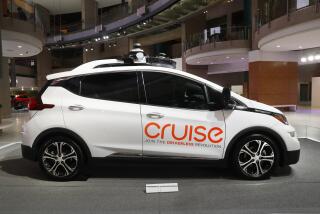Opinion: Appy New Year: Flywheel helps riders avoid surge pricing, hire real cabbies
There’s a rather thin line between “surge pricing” and gouging, as riders of Uber have learned. I noted the other day how Uber dinged people fleeing the area where a man had taken hostages in Sydney, Australia, this month. The concept is vintage free-market: Charge what the market will bear. But that’s one of the reasons we ask government to regulate certain industries -- to ensure against unfair pricing. Especially at times when the customer has limited options.
And New Year’s Eve is a perfect time to price gouge -- all those partiers who shouldn’t drive themselves home are low-hanging fruit. Normally, you’d expect them to get a designated driver involved in their plans, or call a cab. Last year, as Uber was expanding its operation, the app-happy set turned to the ride-sharing concept (a misnomer: people are selling rides, not sharing trips) and found themselves charged three and four times more than the ride normally would have cost.
In a rare personal defense of market forces, I like what Flywheel has done. It’s a new app that works with regulated cab companies to let people summon a ride via their smartphones -- just like Uber, Lyft and the other so-called ride-sharing apps. But instead of getting a poorly vetted driver working part time or as a lark, the fares are met by credentialed drivers working for regulated cab companies (so far in limited cities, including Los Angeles). The fees are whatever the normal meter-measured regulated rate would be, plus a $1 service charge and whatever tip the riders feels like offering.
And there’s no surge pricing. In fact, riders in San Francisco and Seattle get a $10 flat rate for a few hours on either side of the champagne-popping hour.
So in this case, the market that gave rise to the hipster-hucksterism of ride-sharing has also given rise to its app competitor. That’s a welcome development. But it’s not enough, especially given the woefully uneven conditions between the ride-sharing model and traditional cab companies.
My dislike for the new sharing-economy version of taxi service is pretty straightforward. As I wrote the other day, Uber et al. are not “disrupting” the taxi industry. Rather they are “simply doing end runs around regulatory practices that have been in place for decades, practices designed to protect the public from, yes, price gouging, not to mention from being driven around by people who should not be trusted to perform that task. Taxi rates are established by taxi commissions, offering consumers predictability and protections against the unscrupulous. Surge pricing, on the other hand, is the free market run amok, and to an offensive level in Sydney.
“The right thing to do is reclassify Uber et al. as taxi services and bring them under the appropriate, and stricter, local regulatory systems. Short of that, fairness dictates those local regulations be scrapped so the traditional taxi services can compete on a more level playing field.”
I still think the best solution is to curb the ride-sharing model until those businesses follow the same regulations as cab companies. But until then, using a smartphone to find a well-regulated ride home is a pretty good alternative.
Follow Scott Martelle on Twitter @smartelle.
More to Read
A cure for the common opinion
Get thought-provoking perspectives with our weekly newsletter.
You may occasionally receive promotional content from the Los Angeles Times.











